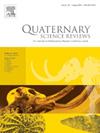The extinct Notiomastodon platensis (proboscidea, Gomphoteriidae) inhabited mediterranean ecosystems during the Late Pleistocene in north-central Chile (31°S–36°S)
IF 3.2
1区 地球科学
Q1 GEOGRAPHY, PHYSICAL
引用次数: 0
Abstract
Limited pollen and limnogeological evidence show that central Chile (31°S–36° S) had a more temperate climate during the Late Pleistocene. Questions remain, however, regarding the extent of the mediterranean sclerophyllous forest currently found in this region and its postglacial dynamics. The extinct Notiomastodon platensis was the only proboscidean species that inhabited central Chile and ranged across a broad latitudinal range (31°S–42°S) during the Pleistocene. Although this species was a mixed-feeder, we reconstructed past ecosystems when these animals were alive using stable isotope evidence from dental root collagen (δ13C and δ15N) of N. platensis specimens collected from present-day semi-arid and mediterranean ecosystems in central Chile (31°S–36°S). Compared to modern vegetation isotope baselines, we expected the isotopic value of the Estimated Consumed Diet (ECD) (the probable diet of N. platensis) to be similar to the isotopic signal (low values) from vegetation adapted to temperate rainforests. However, elevated δ15NECD values indicate a paleo-vegetation more similar to a xerophyte scrub influenced by a semi-arid paleoclimate. δ13CECD values reflect a wooded/forested environment but adapted to more arid conditions. Although high δ15N values could be influenced by other non-climatic factors (e.g., grazing effect), our combined evidence suggests that these gomphotheres roamed through ecosystem very similar to those found today in central Chile. Our results show the need for multiproxy reconstructions of past environmental change in Mediterranean regions where the abundance of entomophilous species can lead to biased pollen reconstructions.
智利中北部(31°S-36°S)已灭绝的Notiomastodon platensis(proboscidea, Gomphoteriidae)在晚更新世期间栖息于地中海生态系统中
有限的花粉和石灰地质学证据表明,智利中部(南纬31°-36°)在晚更新世期间气候较为温和。然而,关于目前在这一地区发现的地中海硬叶林的范围及其冰川期后的动态,仍然存在疑问。已灭绝的Notiomastodon platensis是更新世期间唯一栖息在智利中部的长鼻类动物,其活动范围横跨广阔的纬度范围(南纬31°-42°)。虽然该物种是一种混食动物,但我们利用从智利中部(31°S-36°S)现今半干旱和地中海生态系统中采集的N. platensis标本的牙根胶原蛋白(δ13C和δ15N)中获得的稳定同位素证据,重建了这些动物活着时的生态系统。与现代植被同位素基线相比,我们预计估计消耗食物(ECD)(N. platensis 的可能食物)的同位素值与适应温带雨林植被的同位素信号(低值)相似。然而,δ15NECD值升高表明古植被更类似于受半干旱古气候影响的旱生灌丛。δ13CECD值反映了有林/森林环境,但适应更干旱的条件。虽然高δ15N值可能受到其他非气候因素(如放牧效应)的影响,但我们的综合证据表明,这些冈底斯猿漫游的生态系统与今天在智利中部发现的生态系统非常相似。我们的研究结果表明,在地中海地区,嗜昆虫物种的丰富性可能会导致花粉重建的偏差,因此需要对过去的环境变化进行多代理重建。
本文章由计算机程序翻译,如有差异,请以英文原文为准。
求助全文
约1分钟内获得全文
求助全文
来源期刊

Quaternary Science Reviews
地学-地球科学综合
CiteScore
7.50
自引率
15.00%
发文量
388
审稿时长
3 months
期刊介绍:
Quaternary Science Reviews caters for all aspects of Quaternary science, and includes, for example, geology, geomorphology, geography, archaeology, soil science, palaeobotany, palaeontology, palaeoclimatology and the full range of applicable dating methods. The dividing line between what constitutes the review paper and one which contains new original data is not easy to establish, so QSR also publishes papers with new data especially if these perform a review function. All the Quaternary sciences are changing rapidly and subject to re-evaluation as the pace of discovery quickens; thus the diverse but comprehensive role of Quaternary Science Reviews keeps readers abreast of the wider issues relating to new developments in the field.
 求助内容:
求助内容: 应助结果提醒方式:
应助结果提醒方式:


